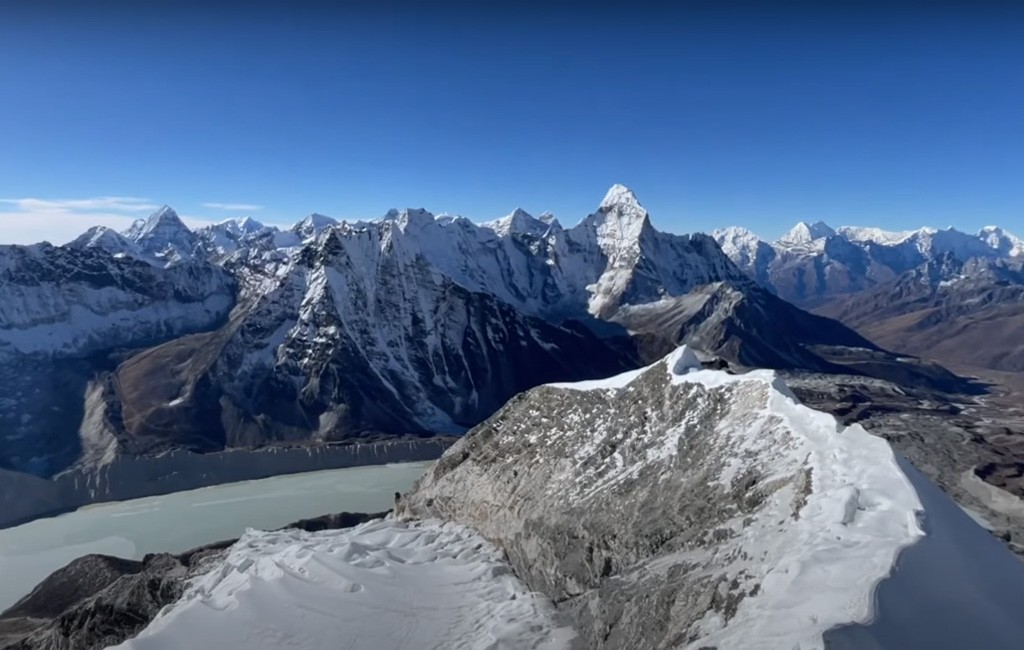
Beyond the tall giants like Everest, many Himalayan peaks turn Nepal into an adventurous playground for trekkers. Here, one can stroll through valleys flowing with culture and lock horns with lung-busting climbs up to 6,000m summits.
From short multi-day village-to-village treks to multi-week climbing adventures, seasoned mountaineers and newcomer trekkers alike have various options.
In this post, we bring our picks for the top 5 trekking peaks showcasing the best Nepal offers. From accessible trails to Everest Base Camp to technical ascents up 6,000+ meter summits, these journeys will lead you through the ultimate adventure.
Each peak promises stunning vistas, unique Himalayan landscapes and a thrilling journey. The memory stays forever as soon as you descend into the valleys below.
We have handpicked these 5 epic trekking peaks that should feature on every visitor’s Nepal bucket list. Get your gear ready and join us on an incredible journey! The Himalayas are waiting for you.
An Overview of Trekking Peaks
Trekking peaks are mountain summits that range from 5,000 to 6,500 meters. It is a full-scale mountaineering journey, though specialized climbing equipment is not in use.
Not just for experienced trekkers, these peaks are the ultimate adventure for intermediate trekkers. The ascent often involves physically demanding altitude hiking for days. Climbers occasionally navigate through steep paths, glaciers, snow, and ice climbing. All of these efforts result in the breathtaking vistas from the heights.
Trekking peaks, while not as technically tough as Himalayan giants like Everest, demands one’s endurance and resolve. Additionally, sufficient acclimatization and fitness are a must. That is why Nepal’s trekking peaks test those who stand beyond their limits.
Differences Between Trekking Peaks and Expedition Peaks
While trekking and expedition peaks offer thrilling Himalayan ascents, they pose vastly different difficulty levels and demands on climbers. Trekking peaks are suitable for relatively experienced trekkers, while climbing an expedition peak requires true mountaineering skills and advanced technical expertise.
The core differences lie in the following key areas:
Altitude and Difficulty
Trekking peaks sit in the 5,500 to 6,450 meter range, challenging trekkers with reasonable fitness. Expedition peaks exceed 6,500 meters, demanding greater physical capabilities and mountaineering proficiency to traverse more extreme terrain.
Technical Requirements
Trekking peaks may utilize basic mountaineering gear like crampons and ice axes. Expedition peaks require mastering specialized high-altitude equipment and rope/rescue techniques.
Duration
Trekking peak climbs range from days to weeks, allowing flexible timelines. Expedition peaks are multi-week endeavors, needing extended acclimatization and optimum summit condition waits.
While both present immense rewards, these key factors demonstrate how expedition peaks stack up the challenge. Understanding these differences allows climbers to pick the adventure that best matches their capabilities and Himalayan ambitions.
Top 5 Trekking Peaks in Nepal
1. Mera Peak
Regarded as one of Nepal’s most popular and rewarding trekking peaks, Mera Peak stands at an impressive 6,476 meters (21,247 feet) in the Everest region. Though its summit reaches close to the heights of giants like Everest, the climb is suitable for fit trekkers with basic training.
The trail first passes through remote mountain villages and Buddhist monasteries, offering cultural immersion. The ascent up Mera itself involves steep hiking trails, short snow and ice climbs, and spectacular views. Trekkers need to allow 14-20 days for proper acclimatization. But the reward is stepping atop a Himalayan peak and seeing 5 mountains over 8,000 meters!
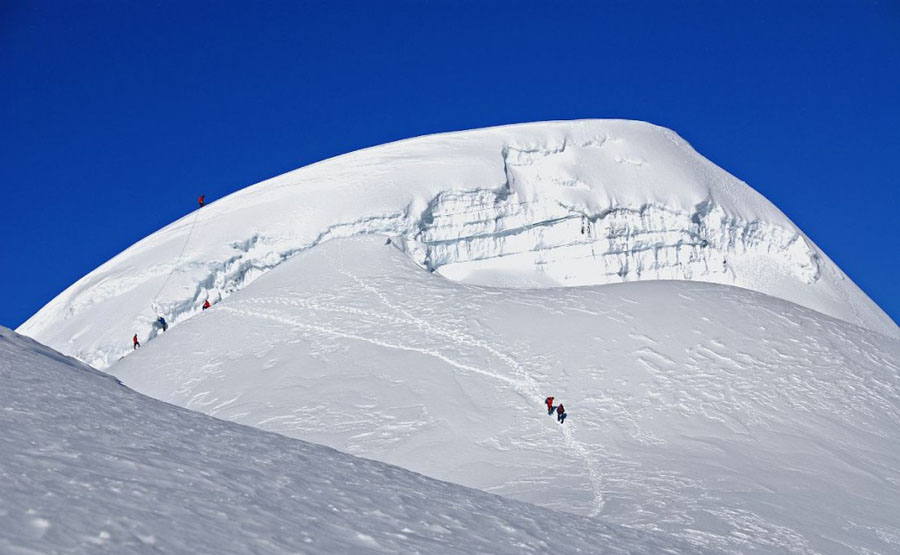
With moderate technical skills needed and incredible rewards on offer, Mera Peak captures the magic of Himalayan trekking. Even the legendary Sir Edmund Hillary used it to prepare for Everest! Due to this, Mera Peak is popular among aspiring mountaineers. Those willing to test themselves and claim a thrilling piece of the Himalayan dream will be rewarded with a lifetime memory.
Quick Facts
Elevation: Mera Peak – 6,476 meters (21,247 feet)
Location: Everest region, Nepal
Grade: Strenuous
Difficulty: Non-technical climb, basic mountaineering skills required
Climbing Season: March to May & September to November
Duration: Around 14-20 days
Accommodation: Teahouses during trek, camping at higher altitudes
Guides: Local guides and Sherpas often hired
Highlights of Mera Peak Climbing
- Mesmerizing vistas of Everest, Lhotse, Makalu, Cho Oyu, and more
- Captivating trek through landscapes and charming Sherpa villages
- Passes through traditional Sherpa villages indulging in their way of life
- Travers diverse landscapes, including rhododendron forests and alpine meadows
- Discover the beauty of both Hinku and Khumbu Valley
- Get the chance to explore Zatrawal Pass (4,600 m)
- Accessible for climbers with prior trekking experience
2. Island Peak
In the towering shadow of Mount Everest lies Island Peak, among the top trekking peaks for mountaineers seeking mesmerizing Himalayan summit views. Officially named Imja Tse (6,189m/20,305 ft), this iconic peak appears like an island rising from the frozen sea of ice surrounding it.
The adventure begins by trekking past picturesque Sherpa villages and following the iconic trail of Everest Base Camp. The technical ascent kicks off as the trek advances for the Island Peak Base Camp. Climbers use ropes, axes, and crampons to traverse perilous crevasses and scale steep headwalls. The ultimate goal is to emerge atop the narrow, thrilling summit finally.

With reasonable fitness and a thirst for high-altitude exploits, the roughly 16-day Island Peak challenge is the ultimate adventure. Basic mountaineering skills are essential. Determined trekkers can proudly stand among the mightiest Himalayan giants.
A true tradition of passage, the perspective gained from Island Peak’s lofty vantage point 6,000 meters up will stay with you for a lifetime.
Quick Facts
Elevation: Island Peak – 6,189 meters (20,305 feet)
Location: Everest region, Nepal
Grade: Strenuous
Difficulty: Non-technical climb, basic mountaineering skills required
Climbing Season: March to May & September to November
Duration: Around 16-20 days
Accommodation: Teahouses during trek, camping at higher altitudes
Guides: Local guides and Sherpas often hired
Highlights of Island Peak Climbing
- Get up close views of Mount Everest and other legendary Himalayan giants like Lhotse, Nuptse, and Ama Dablam
- Trek through charming Sherpa villages following the classic Everest trek trail
- Cross dangerous crevasses with ladders and scale steep headwalls
- Travel through the spectacular landscape of the Khumbu Glacier
- Learn essential mountaineering techniques like rope handling, ice axe arrest, and crampon use
- Experience the varied landscapes, from forests to ice falls to the narrow, snowy summit
- Challenge yourself physically and mentally by trekking and climbing at high elevations over 6,000 meters
- Camp overnight under the dazzling stars and majestic mountain peaks
3. Lobuche East
Rising at 6,119 meters, Lobuche East is a prominent Himalayan peak that allures determined mountaineers. Situated in the dramatic Khumbu region, this popular trekking summit treats climbers to stunning vistas of icons like Everest, Lhotse, Nuptse and Ama Dablam.
The journey begins at Lobuche village base camp, opening up dazzling views of the surrounding icy giants through the wide Lobuche Glacier. After establishing a high camp, the final push is technically demanding, requiring ropework skills to kick step up steep headwalls before an exhausting hike along exposed, precipitous ridges.
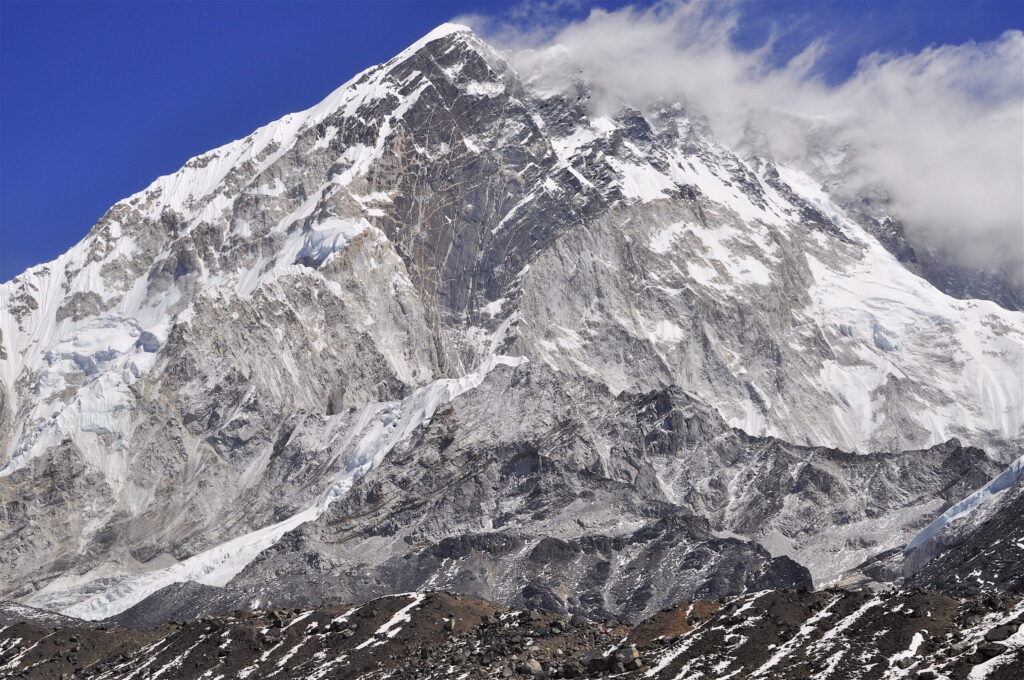
The varying terrain of rocky trails and snow-covered slopes calls for honing rock and ice climbing techniques. Acclimatization is also essential to avoid altitude sickness before the demanding summit ascent.
For experienced alpine enthusiasts, Lobuche East peak fills with thin-air thrills relatively crowd-free compared to busier trekking peaks. The grand sense of achievement upon topping out this Himalayan beast is matched only by the jaw-dropping panorama.
Quick Facts
Elevation: Lobuche East – 6,119 meters (20,075 feet)
Location: Everest region, Nepal
Grade: Challenging
Difficulty: Non-technical climb, basic mountaineering skills required
Climbing Season: March to May & September to November
Duration: Around 15-20 days
Accommodation: Teahouses during trek, camping at higher altitudes
Guides: Local guides and Sherpas often hired
Highlights of Lobuche East Climbing
- Gorgeous views of Mount Everest, Lhotse, Nuptse, Pumori and other peaks
- Trek through retro Sherpa villages and get immersed in the region’s rich culture
- Cross crevasse-ridden glaciers and ascend steep headwalls during the exciting summit push
- Learn to use climbing gear like ropes, carabiners, ice axe and crampons properly during the technical ascent
- Meet experienced climbing guides and Sherpas
- Take in the brilliant night skies filled with dazzling stars from campsites along the route
- Revel in a wonderful sense of personal achievement upon ascending over 20,000 feet to the summit
4. Yala Peak
Rising to 5,732 meters (18,806 feet) among the soaring peaks of Langtang, Yala Peak stands out for its accessibility and rewarding climb. This alluring summit situated in central Nepal treats mountaineers to scenic vistas of renowned giants like Langtang Lirung and Langtang Ri.
The typical Yala Peak adventure begins from Syabrubesi, passing ancient Tibetan villages and allowing trekkers to soak up the area’s rich Buddhist culture against the backdrop of breathtaking valleys.
After establishing base camp, the climb ascends through blooming high-altitude meadows and steep moraine trails before reaching snowy slopes. Though lower in height compared to other Himalayan summits, the relative ease of scaling Yala Peak makes it ideal for beginner climbers seeking their first taste of mountaineering.
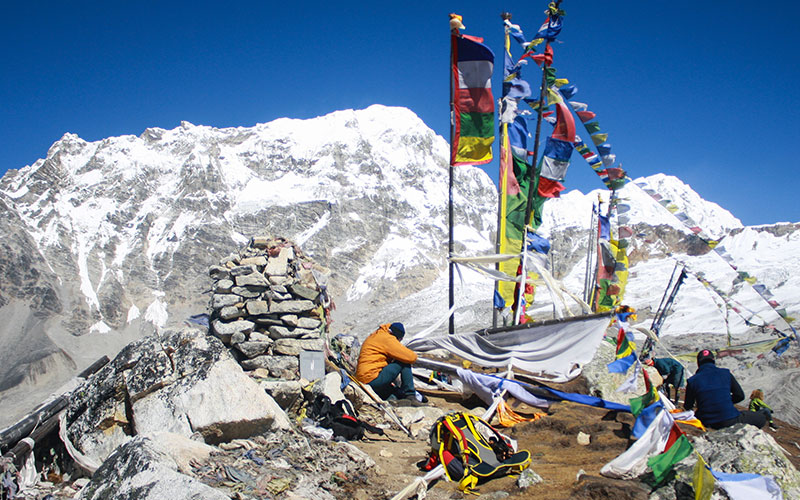
The final steps onto the summit are rewarded by jaw-dropping 360-degree panoramas featuring the mighty Ganesh Himal range and even views across to Shishapangma in Tibet.
For experienced ones, Yala also offers the appeal of a peaceful setting to hone skills. Ultimately, as a gateway to the thrills of Himalayan heights, this manageable yet incredibly scenic peak never disappoints.
Quick Facts
Elevation: Yala Peak – 5,732 meters (18,806 feet)
Location: Langtang region, Nepal
Grade: Strenuous
Difficulty: Non-technical climb, basic mountaineering skills required
Climbing Season: March to May & September to November
Duration: Around 14-20 days
Accommodation: Teahouses during trek, camping at higher altitudes
Guides: Local guides and Sherpas often hired
Highlights of Yala Peak Climbing
- Get panoramic views of legendary Langtang Lirung, Langtang Ri, Ganesh Himal and Shishapangma
- Trek through charming Tamang villages
- Hike through blooming high altitude meadows decorated with rhododendrons and dwarf junipers
- Test your fitness by climbing steep moraine trails and glaciated paths to reach the summit
- Acclimatize properly with overnight stops at camps along the route to avoid altitude sickness
- Meet the friendly sherpas and climbers who frequent this perfect beginner’s peak
- Take in the quiet moments of reflection at the summit, taking in spectacular Himalayan sceneries
5. Chulu West
Chulu West is an enthralling peak nestled high at 6,419 meters (21,055 feet) within the mighty Annapurna Massif. Situated along the legendary Annapurna Circuit, this giant treats trekkers to the rich cultural and natural wonders of the region. The journey passes through lovely villages like Pisang, allowing interactions with Tibetan Buddhists and soaking up the spiritual ambience.
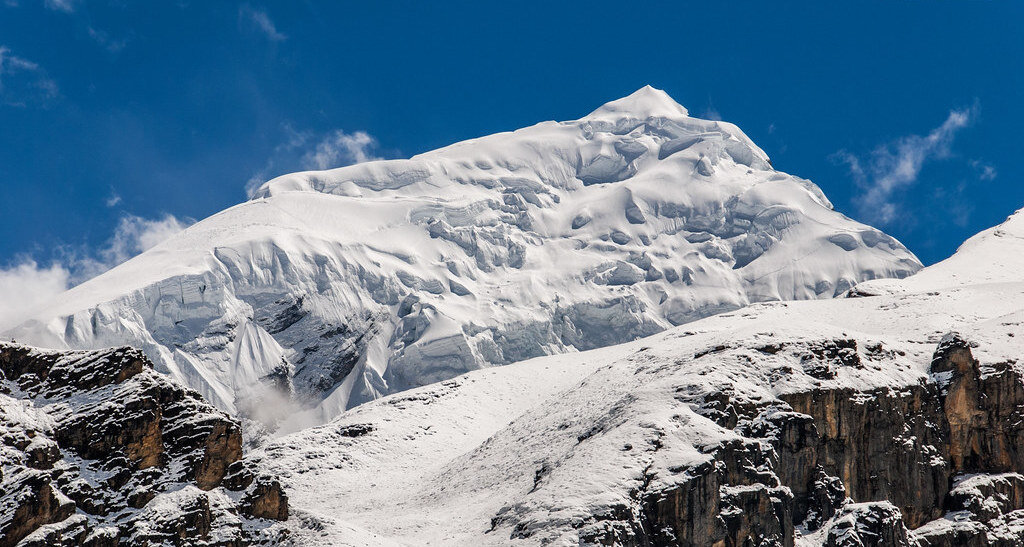
The base camp rests below the vast slopes of Chulu West. Here, advanced preparations and acclimatization are key before attempting the serious summit assault. Climbers taking on the final push must harness technical skills in ice axe work and rock climbing to conquer the peak’s glacial moraines and knife-edge ridges.
The summit offers 360-degree vistas – an unrivaled viewpoint featuring the likes of Dhaulagiri, Manaslu and closer Annapurna sisters encircling you. For seasoned mountaineers chasing a balance of cultural immersion and extreme high-altitude challenges, Chulu West checks all the boxes.
Quick Facts
Elevation: Chulu West – 6,419 meters (21,055 feet)
Location: Annapurna region, Nepal
Grade: Strenuous
Difficulty: Non-technical climb, basic mountaineering skills required
Climbing Season: March to May & September to November
Duration: Around 14-20 days
Accommodation: Teahouses during trek, camping at higher altitudes
Guides: Local guides and Sherpas often hired
Highlights of Chulu West Climbing
- Jaw-dropping views of the Annapurna Range, Dhaulagiri, Manaslu and other Himalayan giants
- Trek along the iconic Annapurna Circuit route through gorgeous mountain scenery
- Sharpen mountaineering skills along the journey
- Meet friendly Sherpas and climbers at the camps along the way
- Get a taste of Gurung culture and their way of life
- Walk across Kali Gandaki Gorge Valley
Final Say
And there you have it – our picks for the top 5 trekking peaks in Nepal! Ranging from the world-famous peaks around Everest to hidden gems off the beaten path, these journeys present the ultimate thrill of summiting a Himalayan giant.
Sure, there will be challenges, exhaustion, and moments of questioning your senses along the rugged routes. However, the sweeping views from the top with the clouds mixing below make every ounce of effort worthwhile. You’ll stand taller knowing you overcame and earned your place amid the tallest peaks on the planet!
Posted on



